Shoulder pain can make simple tasks feel impossible. Getting dressed, carrying groceries, or even sleeping can become a daily challenge.
Your rotator cuff is a group of four muscles and tendons that wrap around your shoulder joint. They work together to keep your arm in place and help you lift and rotate it. When these muscles get weak or injured, pain and stiffness follow.
This guide gives you a simple, science-backed routine that takes just 10 minutes a day. These six exercises can help reduce pain and get your shoulder moving better. A 2012 systematic review of 10 randomized controlled trials found that exercise therapy significantly reduces pain and improves shoulder function in patients with rotator cuff issues.
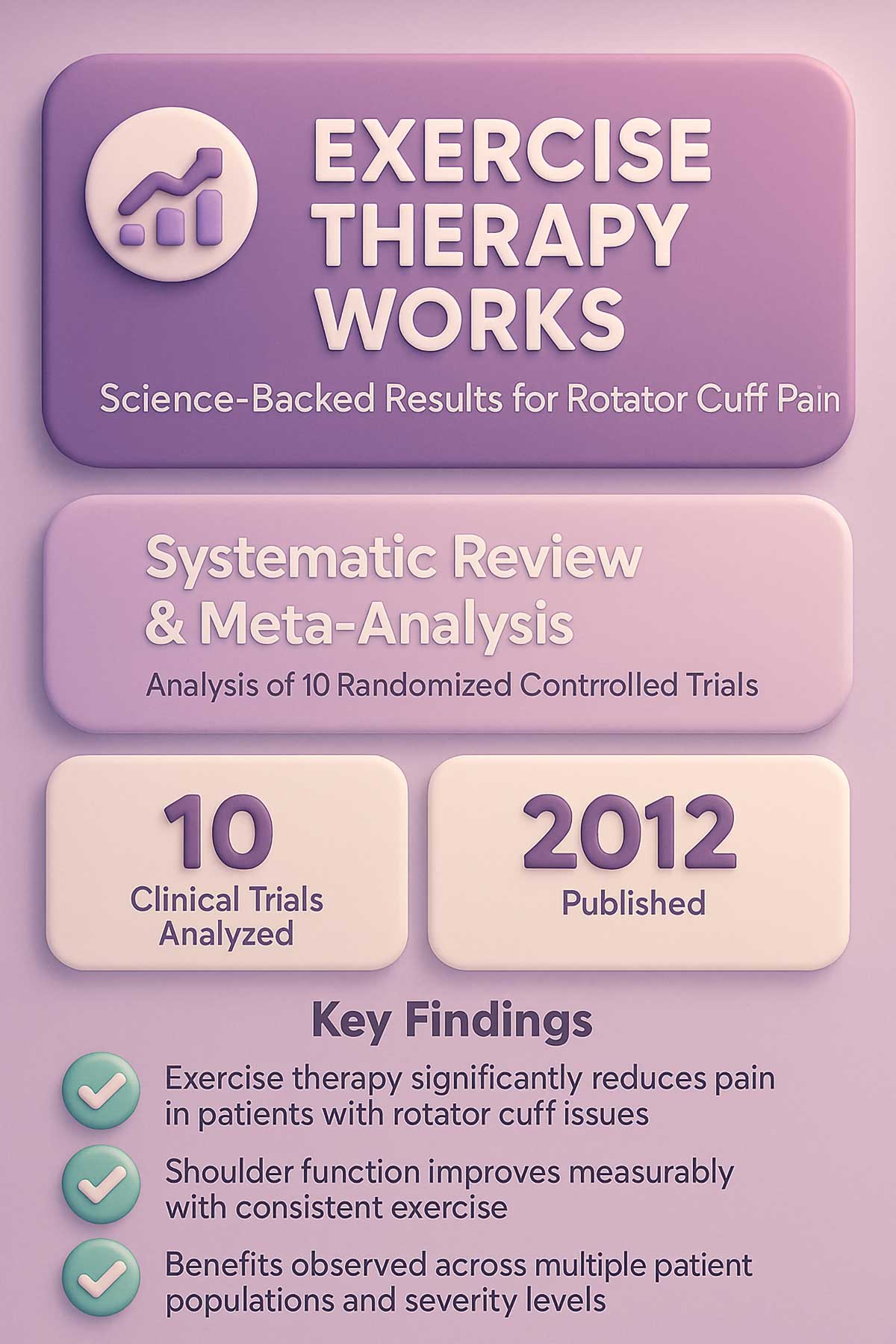
Science Backed Results for Rotator Cuff Pain
Understanding Rotator Cuff Pain
What Causes Rotator Cuff Problems?
Several things can damage your rotator cuff. Overuse is one of the biggest culprits. If you repeat the same arm motions day after day—whether from work, sports, or hobbies—you can wear down these muscles.
Age plays a role too. As you get older, blood flow to your tendons decreases. This makes them weaker and more prone to tears. Most people over 60 have some level of rotator cuff damage, even if they don’t feel pain.
Sudden injuries can also cause problems. A fall on your outstretched arm or lifting something too heavy can strain or tear the muscles. Poor posture makes things worse. Slouching forward puts extra stress on your shoulder joint.
Signs You Need These Exercises
How do you know if your rotator cuff needs help? Here are the most common symptoms:
- A dull ache deep in your shoulder
- Pain when you lift your arm overhead
- Weakness when reaching or lifting
- Trouble sleeping on the affected side
- A clicking or popping sensation when you move your arm
- Difficulty reaching behind your back
If these sound familiar, you’re not alone. Studies show that rotator cuff issues affect up to 30% of people at some point in their lives.
Shoulder Pain Assessment
Answer 8 quick questions to get your personalized exercise plan
Related Shoulder Problems
Your shoulder pain might not be just your rotator cuff. Here are related conditions with similar symptoms:
Shoulder Impingement: Your rotator cuff tendons get pinched between bones. Causes pain when lifting your arm overhead. These exercises help this condition too.
Frozen Shoulder: Your shoulder gets stiff and painful. Range of motion becomes very limited. Needs gentler, longer-term treatment.
Shoulder Bursitis: The fluid-filled sacs in your shoulder get inflamed. Causes pain and swelling. Often occurs alongside rotator cuff issues.
Tendinitis: Your rotator cuff tendons become inflamed from overuse. Very common in athletes and manual laborers.
These exercises benefit most shoulder conditions. But if pain persists beyond 8 weeks, get a proper diagnosis.
When to See a Doctor
Most rotator cuff problems improve with exercise. But some situations need professional help right away.
See a doctor if you have:
- Sudden, severe pain after an injury
- Complete inability to lift your arm
- Shoulder pain lasting more than a few weeks without improvement
- Numbness or tingling in your arm or hand
- Signs of infection like fever, redness, or swelling
Don’t ignore these warning signs. Early treatment prevents bigger problems down the road.
Fix Your Posture, Protect Your Shoulders
Poor posture puts constant stress on your rotator cuff. Here’s how to set yourself up for success throughout your day.
At Your Desk:
- Keep your monitor at eye level
- Shoulders should be relaxed, not hunched
- Elbows bent at 90 degrees
- Take a 2-minute stretch break every hour
While Sleeping:
- Avoid sleeping on your painful shoulder
- Use a pillow between your arms if side-sleeping
- Try a rolled towel under your neck for support
- A pillow under your arm can reduce strain
During Daily Activities:
- Lift items close to your body
- Avoid reaching overhead repeatedly
- Take breaks during repetitive tasks
- Carry bags on your non-painful side
The 10-Minute At-Home Rotator Cuff Rescue Routine
Getting Started
Before you start the exercises, warm up your shoulders. Spend two minutes doing gentle arm circles. Make 10 circles forward, then 10 backward. Add some shoulder rolls. Lift your shoulders up toward your ears, roll them back, and then down.
This warm-up gets blood flowing to your muscles. It prepares your joints for movement.
Here’s what you need to know:
- Start slow and build up gradually
- Stop if you feel sharp pain
- A mild stretch or gentle ache is okay
- Breathe normally throughout each exercise
- Consistency beats intensity
Think of these exercises as medicine. You wouldn’t skip doses of a prescription, right? The same goes here. Daily practice brings results. Research from 2023 confirms that gradual load reintroduction and isometric activation reduce pain and restore function, even with short daily sessions of around 10 minutes.
Know the Difference: Pain vs. Discomfort
GREEN LIGHT – Safe to Continue:
- Mild muscle fatigue or tiredness
- Gentle stretching sensation
- Slight achiness during or after exercise
- Warmth in the muscles
YELLOW LIGHT – Proceed with Caution:
- Discomfort that goes away quickly after stopping
- Mild soreness the next day
- Feeling of tightness that eases with movement
RED LIGHT – Stop Immediately:
- Sharp, stabbing pain
- Pain that gets worse as you continue
- Numbness or tingling down your arm
- Pain that doesn’t improve after 2-3 days rest
- Sudden weakness or inability to move
The 6 Core Exercises: Quick Reference
| Exercise | Equipment Needed | Sets x Reps | Best For | Difficulty |
|---|---|---|---|---|
| Pendulum Swings | Chair/table | 2 x 10 circles each way | Pain relief, warming up | Beginner |
| Doorway Stretch | Doorway | 3 x 30 sec hold | Flexibility, posture | Beginner |
| Isometric External Rotation | Wall | 10 x 10 sec hold | Pain-free strengthening | Beginner |
| Side-Lying External Rotation | Light weight (optional) | 3 x 12 | Strengthening | Beginner-Intermediate |
| Wall Push-Ups | Wall | 3 x 10 | Stability, strength | Beginner |
| Shoulder Blade Squeezes | None | 15 x 5 sec hold | Posture, support muscles | Beginner |
1. Pendulum Swings
This gentle exercise loosens up your shoulder joint. It’s perfect for reducing pain and improving mobility.
How to do it:
Stand next to a table or chair. Bend forward at your waist and place your good hand on the surface for support. Let your affected arm hang straight down. Gently swing your arm in small circles, about the size of a dinner plate. Do 10 circles clockwise, then 10 counterclockwise.
Reps and sets: 2 sets of 10 circles in each direction
Pro-Tip: Keep the movement small and controlled. Your shoulder should stay relaxed. Let gravity do the work. If you tense up, the exercise won’t help as much.
2. Doorway Stretch
Tight chest muscles pull your shoulders forward. This stretch opens up your chest and improves shoulder position.
How to do it:
Stand in a doorway. Place your forearms on each side of the door frame. Your elbows should be at shoulder height. Step forward with one foot until you feel a gentle stretch across your chest and the front of your shoulders. Hold this position.
Reps and sets: Hold for 30 seconds, repeat 3 times
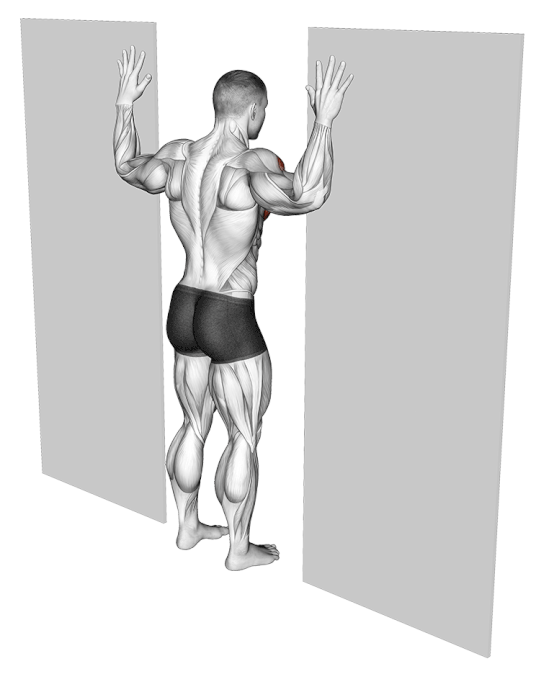
Pro-Tip: Don’t force the stretch. You should feel a gentle pull, not pain. Keep your shoulders down and away from your ears. Breathe deeply to help your muscles relax.
3. Isometric External Rotation
This exercise turns on your rotator cuff muscles without moving your joint. It’s a safe way to build strength when you’re dealing with pain. A 2009 study published in the Journal of Shoulder and Elbow Surgery found that progressive exercise protocols using isometric and eccentric loading improve range of motion and functional scores in people with rotator cuff pain.
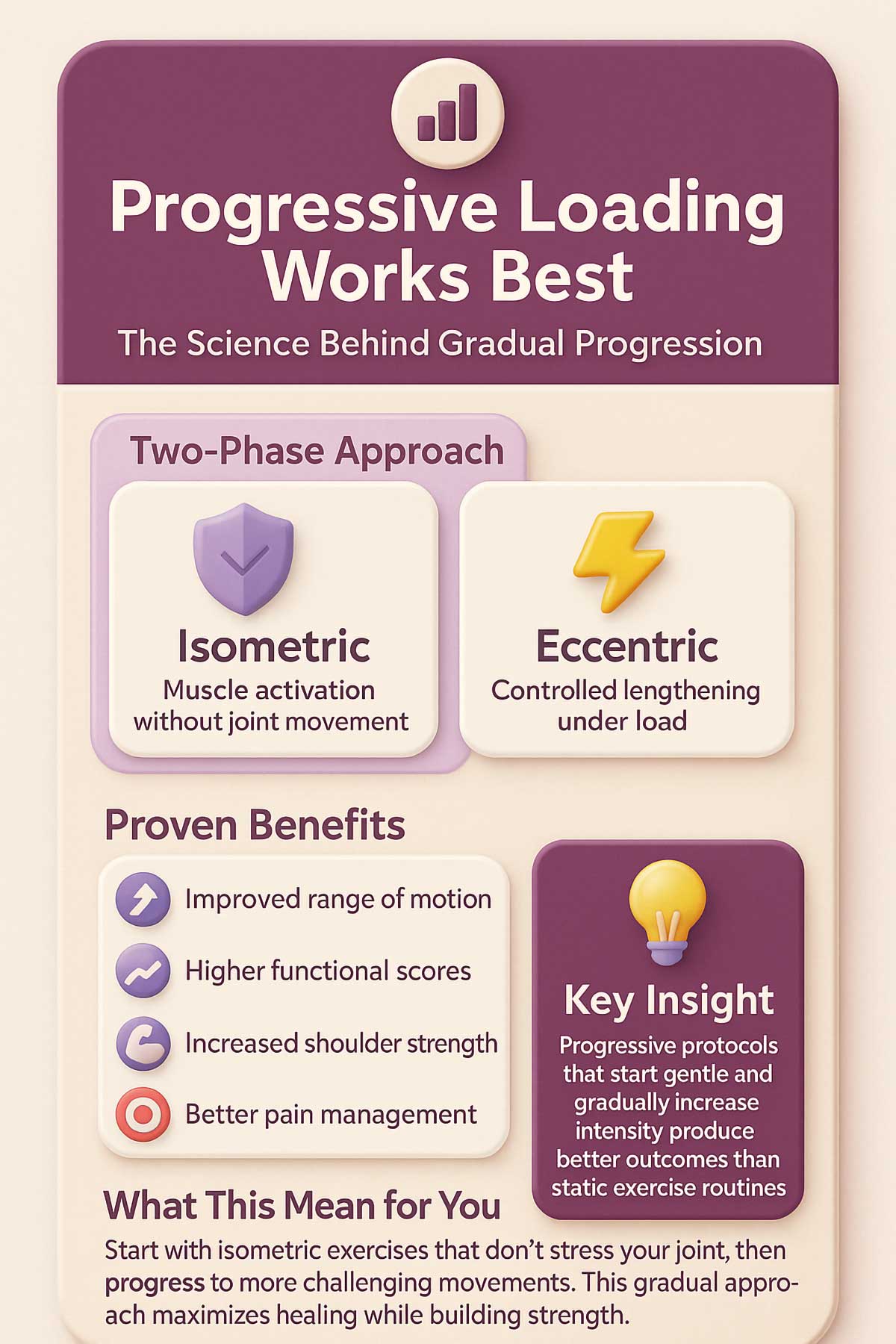
How to do it:
Stand next to a wall. Bend your elbow to 90 degrees and keep it tucked against your side. Press the back of your wrist against the wall. Push into the wall as if you’re trying to rotate your arm outward. Your arm shouldn’t actually move. Hold the pressure.
Reps and sets: Hold for 10 seconds, repeat 10 times
Pro-Tip: Start with gentle pressure. You’re not trying to knock down the wall. Keep your elbow glued to your side. If it moves away from your body, you’re doing it wrong.
4. Side-Lying External Rotation
This classic exercise strengthens the back of your rotator cuff. It’s one of the most effective moves for shoulder health.
How to do it:
Lie on your side with your affected arm on top. Bend your elbow to 90 degrees. Keep your elbow tucked against your side. Slowly rotate your forearm up toward the ceiling. Lower it back down with control.
You can start without any weight. When that gets easy, hold a light can of soup. After a week or two, try a 2-3 pound weight or resistance band.
Reps and sets: 3 sets of 12 reps
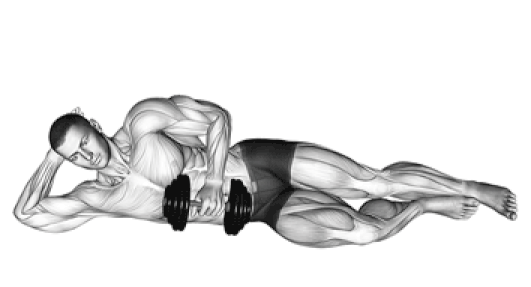
Pro-Tip: Keep your elbow pressed against your side through the entire movement. Don’t let it drift forward or backward. Move slowly. Taking 2 seconds to lift and 2 seconds to lower works well.
5. Wall Push-Ups
Regular push-ups can be too much for a painful shoulder. Wall push-ups give you the benefits without the stress.
How to do it:
Stand facing a wall. Place your hands flat against it at shoulder height. Your feet should be about 2 feet from the wall. Bend your elbows and lean toward the wall. Keep your body in a straight line. Push back to the starting position.
Reps and sets: 3 sets of 10 reps
Pro-Tip: Keep your core tight and don’t let your hips sag. Focus on squeezing your shoulder blades together as you push away from the wall. This turns on the muscles that support your shoulder joint.
6. Shoulder Blade Squeezes
Poor posture puts extra strain on your rotator cuff. This exercise strengthens the muscles between your shoulder blades.
How to do it:
Sit or stand with good posture. Pull your shoulder blades back and down, as if you’re trying to squeeze a pencil between them. Don’t shrug your shoulders up. Hold the squeeze.
Reps and sets: Hold for 5 seconds, repeat 15 times
Pro-Tip: Think about pulling your shoulders away from your ears while you squeeze. Your chest should open up slightly. This exercise seems simple, but it makes a big difference over time.
10-Minute Rotator Cuff Routine
Follow along with guided timers and audio cues
What's Included:
- Warm-Up: Arm circles and shoulder rolls (2 min)
- Exercise 1: Pendulum Swings (1 min)
- Exercise 2: Doorway Stretch (1.5 min)
- Exercise 3: Isometric External Rotation (1.5 min)
- Exercise 4: Side-Lying External Rotation (2 min)
- Exercise 5: Wall Push-Ups (1 min)
- Exercise 6: Shoulder Blade Squeezes (1 min)
- Cool Down: Gentle stretches (30 sec)
Routine Complete!
Great job! You completed your 10-minute routine.
Don’t Have Equipment? Try These Swaps
| Recommended | Easy Alternative | Found At |
|---|---|---|
| Light dumbbell (2-3 lbs) | Can of soup or beans (14-16 oz) | Your pantry |
| Resistance band | Rolled towel or stretchy leggings | Your closet |
| Exercise mat | Folded towel or blanket | Your linen closet |
| Stability ball | Couch cushion or pillow | Your living room |
Cool Down
After you finish the six exercises, spend a minute or two stretching gently. Do a few more pendulum swings. Roll your shoulders forward and back. This helps your muscles recover and prevents stiffness.
Your Action Plan for Success
Sample Week Schedule
| Day | Morning Routine | Evening Notes |
|---|---|---|
| Monday | Full 10-min routine | How did it feel? Rate pain 1-10 |
| Tuesday | Full 10-min routine | Note any improvements |
| Wednesday | Full 10-min routine | Check form in mirror |
| Thursday | Rest day (gentle stretches only) | Ice if needed |
| Friday | Full 10-min routine | Try adding 1-2 more reps |
| Saturday | Full 10-min routine | Assess weekly progress |
| Sunday | Rest day or light routine | Plan for next week |
Note: Aim for 5-6 days per week for best results.
The 4-Week Progression Plan
Starting is great. But making progress keeps you motivated. Here’s how to advance your routine safely.
Week 1: Focus on form. Do all exercises with no added weight. If an exercise causes sharp pain, skip it and try again in a few days.
Week 2: Increase your repetitions by 2-3 for each exercise. Your muscles should feel slightly tired by the end, but not exhausted.
Week 3: Add light resistance. Use a resistance band or 2-3 pound weight for the side-lying external rotation. You can also stand farther from the wall during push-ups.
Week 4: Increase resistance slightly or add a second set to each exercise. Hold stretches for 40-45 seconds instead of 30.
After four weeks, you should notice less pain and better range of motion. A 2020 systematic review found that exercise therapy—both supervised and home-based—produces measurable improvements in pain, disability, and mobility across age groups with rotator cuff disorders.
Keep going. Many people see their best results between weeks 8 and 12.
Common Mistakes to Avoid
Even simple exercises can cause problems if done wrong. Watch out for these pitfalls:
Using too much weight too soon: More weight doesn’t mean faster results. It just means more risk of injury. Start light and build slowly.
Pushing through sharp pain: Some discomfort is normal when you start exercising. Sharp or stabbing pain is not. Stop immediately if you feel it.
Using improper form: Bad form puts stress on the wrong muscles. It can make your shoulder worse instead of better. If you’re not sure you’re doing an exercise correctly, ask a physical therapist or watch reputable video demonstrations.
Skipping the warm-up: Jumping straight into exercises with cold muscles increases your injury risk. Those two minutes of arm circles really matter.
Doing too much too fast: You might feel great one day and want to double your reps. Don’t. Your tendons need time to adapt. Stick to the plan.
Stopping when you feel better: This is huge. Most people quit as soon as their pain improves. Then the problem comes back. Keep doing these exercises at least 3-4 times per week, even after you feel better.
Foods That Support Shoulder Recovery
Your diet can help reduce inflammation and speed healing. Here’s what to focus on.
Foods to Include:
Omega-3 Rich Foods: Salmon, mackerel, sardines, walnuts, and flaxseeds fight inflammation. Aim for fatty fish 2-3 times per week.
Colorful Vegetables: Dark leafy greens, bell peppers, and berries contain antioxidants that help repair tissue damage.
Lean Protein: Chicken, turkey, eggs, and Greek yogurt provide the building blocks your muscles need to heal. Aim for 20-30 grams per meal.
Anti-Inflammatory Spices: Turmeric and ginger have natural pain-relieving properties. Add them to smoothies, soups, or tea.
Foods to Limit:
- Processed foods high in sugar
- Fried foods and trans fats
- Excessive alcohol
- Foods high in refined carbohydrates
Sample Recovery Smoothie Recipe:
- 1 cup spinach
- 1/2 cup frozen berries
- 1 tablespoon ground flaxseed
- 1 scoop vanilla protein powder
- 1/2 teaspoon turmeric
- 1/4 teaspoon ginger
- 1 cup unsweetened almond milk
- Ice as needed
Blend until smooth. Drink within 30 minutes after your exercise routine.
Conclusion
Your shoulder pain doesn’t have to control your life. These six exercises take just 10 minutes a day. You can do them in your living room before work or while watching TV.
Research backs up this approach. Multiple studies show that exercise therapy reduces pain and improves function in people with rotator cuff problems. Home programs work just as well as supervised therapy for most people.
A 2019 clinical study showed that home-based rotator cuff exercise programs produce outcomes comparable to supervised physiotherapy, with measurable improvements in pain and strength after 12 weeks.
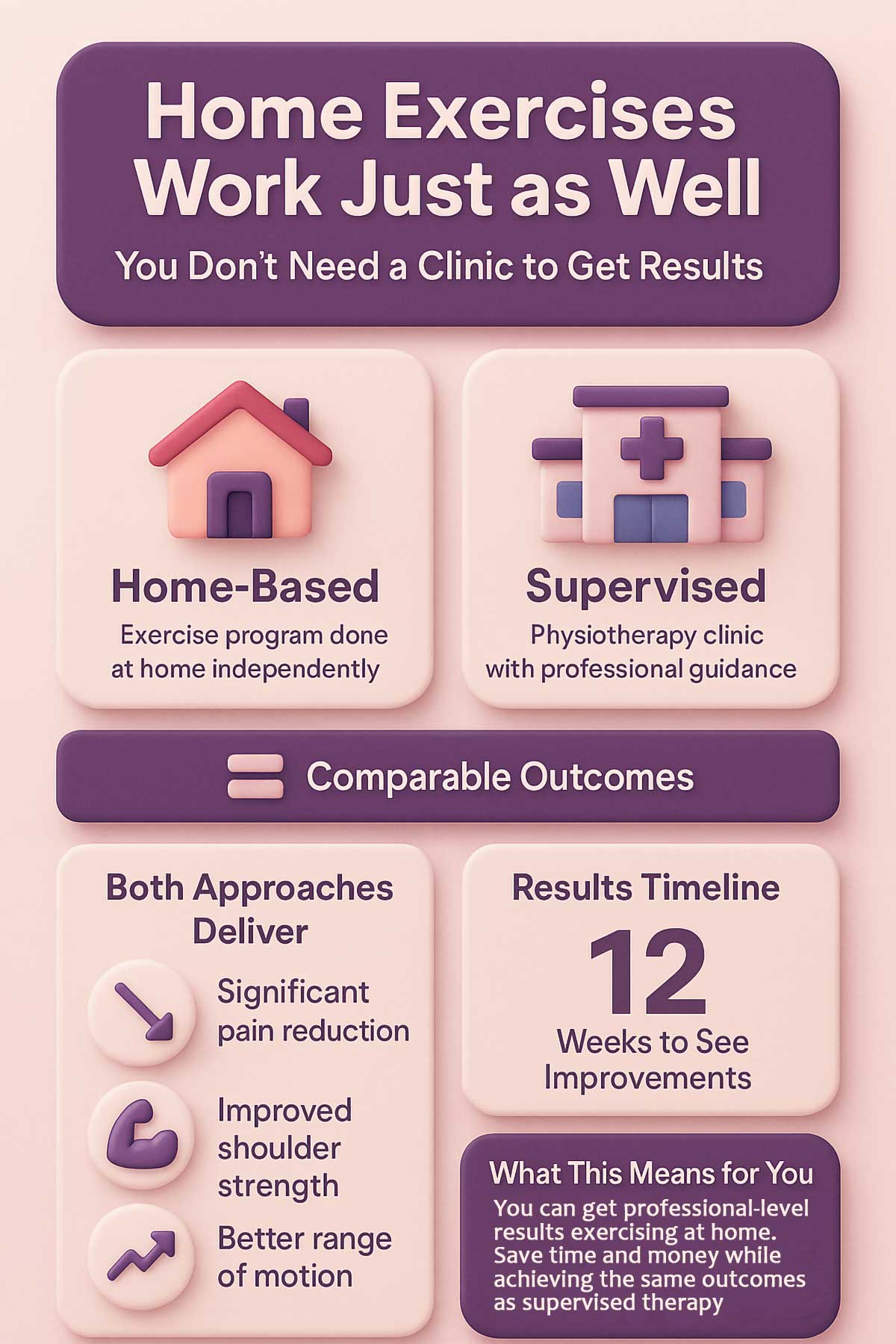
Consistency is key. You won’t see major changes overnight. But if you stick with this routine for a few weeks, you’ll notice a difference. Your shoulder will feel stronger. Daily tasks will get easier. You might even sleep better.
Start today. Do the warm-up and try each exercise. See how your shoulder feels. Tomorrow, do it again. In a month, you’ll be glad you did.
FAQs
How long before I feel better?
Most people notice some improvement within 1-2 weeks. Significant changes typically happen between weeks 4-8. Give it at least 6 weeks before deciding if the program works for you. A 2020 study on resistance-band and low-load strengthening showed that adults with cuff tendinopathy experienced significant improvements in shoulder function and pain reduction, with most benefits appearing after consistent practice over several weeks.
Can I do these exercises if I have a rotator cuff tear?
It depends on the severity. Small tears often heal with exercise. Large or complete tears may need surgery. Check with your doctor first if you suspect a tear. A 2005 study published in the American Journal of Sports Medicine found that exercise programs for rotator cuff issues are comparable to surgery for many patients, particularly those with partial tears or tendinopathy.
Should I use ice or heat?
Use ice for acute pain or swelling (first 48-72 hours after injury). Apply for 15-20 minutes, 3-4 times daily. Use heat for chronic stiffness or before exercise. Never apply heat to a swollen area.
Can I do other workouts while doing these exercises?
Yes, but avoid activities that cause pain. Skip overhead lifts, throwing motions, and exercises that stress your shoulder. Swimming, walking, and lower body exercises are usually fine.
What if one exercise hurts but others don’t?
Skip the painful exercise for now. Focus on the ones you can do comfortably. Try the painful exercise again after a week or two. Your shoulder may need more time to heal.
Do I need physical therapy instead?
Try this home program first if your pain is mild to moderate. See a physical therapist if pain doesn’t improve after 6-8 weeks, gets worse, or limits your daily activities significantly.
How long have you been dealing with shoulder pain?
Less than a month? A few months? Over a year? The timeline doesn’t matter as much as your commitment to getting better. You can start today.


